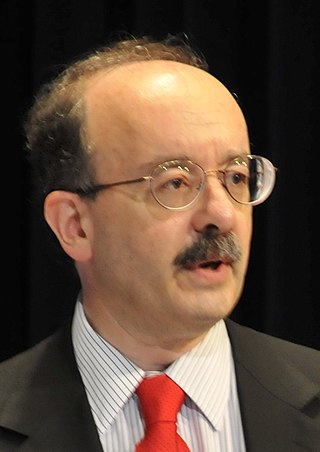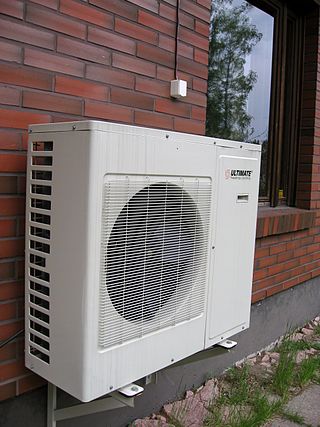An autonomous building is a building designed to be operated independently from infrastructural support services such as the electric power grid, gas grid, municipal water systems, sewage treatment systems, storm drains, communication services, and in some cases, public roads. The literature mostly refers to housing, or the autonomous house.

Appropriate technology is a movement encompassing technological choice and application that is small-scale, affordable by its users, labor-intensive, energy-efficient, environmentally sustainable, and locally autonomous. It was originally articulated as intermediate technology by the economist Ernst Friedrich "Fritz" Schumacher in his work Small Is Beautiful. Both Schumacher and many modern-day proponents of appropriate technology also emphasize the technology as people-centered.

Amory Bloch Lovins is an American writer, physicist, and former chairman/chief scientist of the Rocky Mountain Institute. He has written on energy policy and related areas for four decades, and served on the US National Petroleum Council, an oil industry lobbying group, from 2011 to 2018.
Sustainable living describes a lifestyle that attempts to reduce the use of Earth's natural resources by an individual or society. Its practitioners often attempt to reduce their ecological footprint by altering their home designs and methods of transportation, energy consumption and diet. Its proponents aim to conduct their lives in ways that are consistent with sustainability, naturally balanced, and respectful of humanity's symbiotic relationship with the Earth's natural ecology. The practice and general philosophy of ecological living closely follows the overall principles of sustainable development.

Distributed generation, also distributed energy, on-site generation (OSG), or district/decentralized energy, is electrical generation and storage performed by a variety of small, grid-connected or distribution system-connected devices referred to as distributed energy resources (DER).

Photovoltaics (PV) is the conversion of light into electricity using semiconducting materials that exhibit the photovoltaic effect, a phenomenon studied in physics, photochemistry, and electrochemistry. The photovoltaic effect is commercially used for electricity generation and as photosensors.

RMI, formerly known as the Rocky Mountain Institute, is a think tank in the United States co-founded by Amory Lovins dedicated to research, publication, consulting, and lecturing in the field of sustainability, with a focus on profitable innovations for energy and resource efficiency. The Rocky Mountain Institute was established in 1982 and has grown into a broad-based institution with over 600 staff and an annual budget of $120+ million. RMI's work is independent and non-adversarial, with an emphasis on market-based solutions.

In 1976, energy policy analyst Amory Lovins coined the term soft energy path to describe an alternative future where energy efficiency and appropriate renewable energy sources steadily replace a centralized energy system based on fossil and nuclear fuels.

Environmental technology (envirotech) is the use of engineering and technological approaches to understand and address issues that affect the environment with the aim of fostering environmental improvement. It involves the application of science and technology in the process of addressing environmental challenges through environmental conservation and the mitigation of human impact to the environment.
Energy demand management, also known as demand-side management (DSM) or demand-side response (DSR), is the modification of consumer demand for energy through various methods such as financial incentives and behavioral change through education.

A negawatt-hour is a unit of energy saved as a direct result of energy conservation measures, such as reducing the use of heat or electricity. The concept was developed after Amory Lovins authored an article published in the March 21, 1985 issue of Public Utilities Fortnightly arguing that utility companies will sell less electricity and more efficiency by marketing 'negawatts'. In Lovins' opinion, utility customers don't want kilowatt-hours of electricity; they want energy services such as hot showers, cold beer, lit rooms, and spinning shafts, which can come more cheaply if electricity is used more efficiently. Lovins credited the term to a typo in a document by the Colorado Public Utilities Commission in which the word "megawatt" was misspelled.
Factor Ten is a social and economic policy program developed by the Factor Ten institute with the stated goal of "provid[ing] practical support for achieving significant advances in sustainable value creation, in particular through increases in resource productivity throughout the economy.

Winning the Oil Endgame: Innovation for Profits, Jobs and Security is a 2005 book by Amory B. Lovins, E. Kyle Datta, Odd-Even Bustnes, Jonathan G. Koomey, and Nathan J. Glasgow, published by the Rocky Mountain Institute. It presents an independent, transdisciplinary analysis of four ways to reduce petroleum dependence in the United States:

Brittle Power: Energy Strategy for National Security is a 1982 book by Amory B. Lovins and L. Hunter Lovins, prepared originally as a Pentagon study and re-released in 2001 following the September 11 attacks. The book argues that the U.S. domestic energy infrastructure is very vulnerable to disruption, whether by accident or malice, often even more so than US technology is vulnerable to disruption of the imported oil supply. According to the authors, a resilient energy system is feasible, costs less, works better, and is favoured in the market, but is rejected by U.S. policy. In the preface to the 2001 edition, Lovins explains that these themes are still very current.
The environmental benefits of renewable energy technologies are widely recognised, but the contribution that they can make to energy security is less well known. Renewable technologies can enhance energy security in electricity generation, heat supply, and transportation. Since renewable energy is more evenly distributed than fossil fuels at the global level, the use of renewable energy technologies can also lead to decentralized and self-sufficient energy systems and reduce energy dependencies among countries.

100% renewable energy is the goal of the use renewable resources for all energy. 100% renewable energy for electricity, heating, cooling and transport is motivated by climate change, pollution and other environmental issues, as well as economic and energy security concerns. Shifting the total global primary energy supply to renewable sources requires a transition of the energy system, since most of today's energy is derived from non-renewable fossil fuels.

Thin-film solar cells are a type of solar cell made by depositing one or more thin layers of photovoltaic material onto a substrate, such as glass, plastic or metal. Thin-film solar cells are typically a few nanometers (nm) to a few microns (μm) thick–much thinner than the wafers used in conventional crystalline silicon (c-Si) based solar cells, which can be up to 200 μm thick. Thin-film solar cells are commercially used in several technologies, including cadmium telluride (CdTe), copper indium gallium diselenide (CIGS), and amorphous thin-film silicon.

Policy makers often debate the constraints and opportunities of renewable energy.

Reinventing Fire: Bold Business Solutions for the New Energy Era is a 2011 book, by Amory B. Lovins and the Rocky Mountain Institute, that explores converting the United States to almost total reliance on renewable energy sources, such as solar energy and wind power. Lovins says that renewable energy is already cheaper than fossil fuels and his analysis predicts further reductions in renewable energy prices.

Sustainable refurbishment describes working on existing buildings to improve their environmental performance using sustainable methods and materials. A refurbishment or retrofit is defined as: "any work to a building over and above maintenance to change its capacity, function or performance' in other words, any intervention to adjust, reuse, or upgrade a building to suit new conditions or requirements". Refurbishment can be done to a part of a building, an entire building, or a campus. Sustainable refurbishment takes this a step further to modify the existing building to perform better in terms of its environmental impact and its occupants' environment.
















